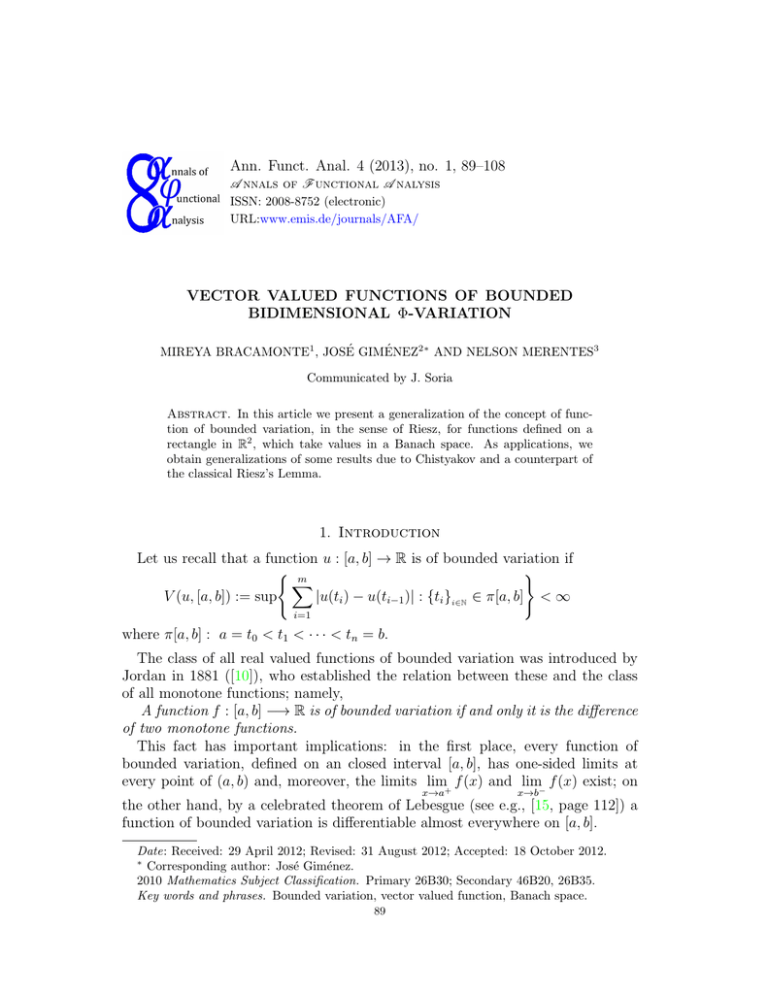Ann. Funct. Anal. 4 (2013), no. 1, 89–108 BIDIMENSIONAL Φ-VARIATION
advertisement

Ann. Funct. Anal. 4 (2013), no. 1, 89–108
A nnals of F unctional A nalysis
ISSN: 2008-8752 (electronic)
URL:www.emis.de/journals/AFA/
VECTOR VALUED FUNCTIONS OF BOUNDED
BIDIMENSIONAL Φ-VARIATION
MIREYA BRACAMONTE1 , JOSÉ GIMÉNEZ2∗ AND NELSON MERENTES3
Communicated by J. Soria
Abstract. In this article we present a generalization of the concept of function of bounded variation, in the sense of Riesz, for functions defined on a
rectangle in R2 , which take values in a Banach space. As applications, we
obtain generalizations of some results due to Chistyakov and a counterpart of
the classical Riesz’s Lemma.
1. Introduction
Let us recall that a function u : [a, b] → R is of bounded variation if
( m
)
X
V (u, [a, b]) := sup
|u(ti ) − u(ti−1 )| : {ti }i∈N ∈ π[a, b] < ∞
i=1
where π[a, b] : a = t0 < t1 < · · · < tn = b.
The class of all real valued functions of bounded variation was introduced by
Jordan in 1881 ([10]), who established the relation between these and the class
of all monotone functions; namely,
A function f : [a, b] −→ R is of bounded variation if and only it is the difference
of two monotone functions.
This fact has important implications: in the first place, every function of
bounded variation, defined on an closed interval [a, b], has one-sided limits at
every point of (a, b) and, moreover, the limits lim+ f (x) and lim− f (x) exist; on
x→a
x→b
the other hand, by a celebrated theorem of Lebesgue (see e.g., [15, page 112]) a
function of bounded variation is differentiable almost everywhere on [a, b].
Date: Received: 29 April 2012; Revised: 31 August 2012; Accepted: 18 October 2012.
∗
Corresponding author: José Giménez.
2010 Mathematics Subject Classification. Primary 26B30; Secondary 46B20, 26B35.
Key words and phrases. Bounded variation, vector valued function, Banach space.
89
90
M. BRACAMONTE, J. GIMÉNEZ, N. MERENTES
Historically one of the most important implications of Jordan’s characterization
is that it permits to extend the Dirichlet’s criterium (for the convergence of
the Fourier series of piecewise monotone functions) to the class of functions of
bounded variation.
The interest generated by this notion has lead to some generalizations of the
concept (see, e.g., [2, 7, 17]). Many of these generalizations are mainly intended to
the search of a bigger class of functions whose elements have pointwise convergent
Fourier series. As in the classical case, this generalizations have found also many
applications in the study of certain differential and integral equations (see, e.g.,
[3]).
In 1910, Riesz ([14]) introduces the class of functions of bounded p-variation
on [a, b] ( 1 ≤ p < ∞); it consists of those functions u : [a, b] → R such that
( n
)
X |u(ti ) − u(ti−1 )|p
R
Vp (u; [a, b]) = sup
: {ti }i∈N ∈ π[a, b] < ∞,
|ti − ti−1 |p−1
i=1
where π[a, b] denotes the set of all partitions {tk }nk=0 of [a, b]; that is, a = t0 <
t1 < · · · < tn = b.
He proved that in the case 1 < p < ∞, this class coincides with the class of those
functions u that are absolutely continuous and whose derivative u0 ∈ Lp [a, b] .
In fact, the renowned Riesz’s Lemma establishes that
VpR (u; [a, b]) < ∞ ⇐⇒ VpR (u; [a, b]) = ku0 kpLp [a,b] .
In this paper we will use the following standard notation (see [5]): N will
denote the set of all continuous convex functions Φ : [0, +∞) → [0, +∞) such
that Φ(ρ) = 0 if and only if ρ = 0, and N∞ the set of all functions Φ ∈ N , for
Φ(ρ)
which the Orlicz condition (also called ∞1 ) holds: lim
= +∞. Any function
ρ→∞
ρ
Φ ∈ N is strictly increasing, and so, its inverse Φ−1 is continuous
and concave;
Φ(ρ)
1
besides, the functions ρ 7−→
and ρ 7−→ ρΦ−1
are nondecreasing for
ρ
ρ
ρ > 0.
One says that a function Φ ∈ N satisfies a condition ∆2 , and writes Φ ∈ ∆2 ,
if there are constants K > 2 and t0 ∈ R such that
Φ(2t) ≤ KΦ(t) for all t ≥ t0 .
(1.1)
For instance, if Φ(x) := tp , p > 1, one may chooses the optimal constant
K = 2p .
In 1953, Medvedev ([18]), gives a generalization of the notion of Riesz bounded
p-variation: given an Φ ∈ N∞ , a function u : [a, b] → R is said to be of bounded
Φ-variation on [a, b], in the sense of Riesz if:
)
( n
X |u(ti ) − u(ti−1 )| |ti − ti−1 | : {ti }i∈N ∈ π[a, b] < ∞.
VΦR (u; [a, b]) := sup
Φ
|t
−
t
|
i
i−1
i=1
FUNCTIONS OF BOUNDED BIDIMENSIONAL Φ-VARIATION
91
The class of all such functions is denoted by RVΦ [a, b]. Cybertowicz and Matuszewska ([8]) also gets the following generalization of the Riesz’s lemma:
Φ(ρ)
= 0. A function u ∈
ρ→0
ρ
Rb
RVΦ [a, b] if and only if, u is absolutely continuous on [a, b] and a Φ(|u0 (t)|)dt <
Rb
∞. In this case we have, VΦR (u; [a, b]) = a Φ(|u0 (t)|)dt.
Proposition 1.1. Let Φ ∈ N∞ such that lim+
In 1998, Chistyakov ([7]), assuming that (X, d) is a metric space, introduced
the notion of Φ-variation in the sense of Jordan, Riesz and Orlicz:
A function u : [a, b] → X is said to be of (total) bounded Φ-variation, in the
sense of Jordan, Riesz and Orlicz if
( m )
X
d(u(tk ), u(tk−1 ))
VΦ,d (u; [a, b]) :=
Φ
(tk − tk−1 ) : {tk }k∈N ∈ π[a, b] < ∞.
t
k − tk−1
k=1
The set of all such functions is denoted by BVΦ,d ([a, b]; X).
The following result is due to Chystiakov ([5, Theorem 3.3]).
Theorem 1.2. Let (X, k · k) be a reflexive Banach space, Φ ∈ N∞ and suppose
that f : [a, b] → X is a mapping of bounded Φ-variation, then f is strongly
differentiable a.e. on [a, b], its derivative f 0 is stronglyR measurable and Bochner
t 0
integrable on [a, b], f is represented as f (t) = f (a) + a f (τ )dτ for all t ∈ [a, b]
and the following integral formula for the Φ-variation holds
Z b
Φ(kf 0 (t)k)dt.
VΦ,d (f, [a, b]) =
a
A multidimensional extension of this notion requires an appropriate generalization of total variation for functions of several variables.
Given two points a = (a1 , a2 ) and b = (b1 , b2 ) in R2 we will denote a rectangle
[a1 , b1 ]×[a2 , b2 ] by Iab . The notation π([x, y]) will stand for the set of all partitions
of a closed interval [x, y] ⊂ R. Accordingly, the set of all partitions of the form
ξ × η of Iab will be denoted as π(Iab ).
Recently, Aziz [1] (see also [2]) introduces the notion of functions of bounded
bidimensional Φ-variation (in the sense of Riesz), for real valued functions defined
on a rectangle Iab ⊆ R2 . In this article, and inspired in [1] and [2], we present a
generalization of this last notion introducing the class RBVΦ (Iab , X), of X-valued
functions of bounded Φ-variation, where X is a Banach space. In particular, we
get the following generalizations of Chistyakov’s result:
Theorem 5.1 Let (X, k · k) be a reflexive Banach space and suppose that
Φ ∈ N∞ and f ∈ RBVΦ (Iab ). Then, for all 0 6= x∗ ∈ X ∗
T VΦR (x∗
◦
f, Iab ; R)
b1
Z b2 ∂(x∗ ◦ f )(x, a2 ) ∂(x∗ ◦ f )(a1 , y) dy
Φ =
Φ dx +
∂x
∂y
a1
a2
Z b1 Z b2 2 ∗
∂ (x ◦ f )(x, y) dydx.
+
Φ ∂x∂y
a1
a2
Z
92
M. BRACAMONTE, J. GIMÉNEZ, N. MERENTES
Corollary 5.3 Let Φ ∈ N∞ and suppose that f : Iab → X, where X is a
reflexive Banach space. If f ∈ C 2 (Iab ) and f ∈ RBV Φ (Iab ) then
T VΦR (f, Iab , X)
b1
Z b2 ∂f (x, a2 ) ∂f (a1 , y) dy
=
Φ Φ dx +
∂x
∂y
a1
a2
Z b1 Z b2 2
∂ f (x, y) Φ +
∂x∂y dydx.
a2
a1
Z
2. bidimensional Φ-variation in the sense of Riesz
In the sequel X will denote a normed linear space and, as usual, N will denote
the set of all natural numbers (positive integers).
Given Iab and a function f : Iab → X we introduce the following notations:
(1) If ξ := {ti }m
i=1 ∈ π[a1 , b1 ]
m
X
kf (ti , a2 ) − f (ti−1 , a2 )k
R
VΦ (f, [a1 , b1 ], ξ) :=
Φ
(ti − ti−1 )
ti − ti−1
i=1
(2) If η := {sj }nj=1 ∈ π[a2 , b2 ]
n
X
kf (a1 , sj ) − f (a1 , sj−1 )k
R
(sj − sj−1 ).
VΦ (f, [a2 , b2 ], η) :=
Φ
sj − sj−1
j=1
(3) The Vitali Difference of a rectangle [t1 , t2 ] × [s1 , s2 ] is defined as:
∆(f, [t1 , t2 ] × [s1 , s2 ]) := f (t1 , s1 ) − f (t1 , s2 ) − f (t2 , s1 ) + f (t2 , s2 ).
(2.1)
Finally,
If ξ := {ti }ni=0 ∈ π[a1 , b1 ] and η := {sj }m
j=0 ∈ π[a2 , b2 ], define
VΦR (f, Iab , ξ, η)
n X
m
X
k∆(f, [ti−1 , ti ] × [sj−1 , sj ])k
(ti − ti−1 )(sj − sj−1 ).
:=
Φ
(ti − ti−1 )(sj − sj−1 )
i=1 j=1
Remark 2.1. Given multi-indexes α = (α1 , α2 ), β = (β1 , β2 ) ∈ (N ∪ {0})2 and x =
(x1 , x2 ) ∈ R2 define:
|α| := α1 + α2 ,
α ± β := (α1 ± β1 , α2 ± β2 )
and αx := (α1 x1 , α2 x2 ).
Then, if xij := (ti−1 , sj−1 ), yij := (ti , sj ) and [xij , yij ] = [ti−1 , ti ] × [sj−1 , sj ] the
expression ∆(f, [xij , yij ]) can be written as
X
(−1)|α| f (αxij + (1 − α)yij ),
(2.2)
|α|≤2
where, the symbol 1 stands for the multi-index (1, 1).
Definition 2.2. Let X be a Banach space, Φ ∈ N , Iab be a rectangle in R2 and
f : Iab → X. Define
(a) the RΦ-variation of the function f (·, a2 ) as
R
V10,Φ
(f, [a1 , b1 ]) :=
sup VΦR (f, [a1 , b1 ], ξ).
ξ∈π[a1 ,b1 ]
FUNCTIONS OF BOUNDED BIDIMENSIONAL Φ-VARIATION
93
(b) Similarly, the RΦ-variation of the function f (a1 , ·) is defined as
R
V01,Φ
(f, [a2 , b2 ]) :=
sup
VΦR (f, [a2 , b2 ], η).
η∈π[a2 ,b2 ]
Finally,
(c) the RΦ-bidimensional variation of f is defined by
R
V11,Φ
(f, Iab ) :=
sup VΦR (f, Iab , ξ, η).
ξ∈π[a1 ,b1 ]
η∈π[a2 ,b2 ]
We will say that f has (total) bounded bi-dimensional Φ-variation, in the
sense of Riesz, on Iab , if
R
R
R
T VΦR (f, Iab , X) := V10,Φ
(f, [a1 , b1 ]) + V01,Φ
(f, [a2 , b2 ]) + V11,Φ
(f, Iab ) < ∞.
The class of such functions will be denoted by RBV Φ (Iab ).
When the role of the space X is clear and unambiguous we simply use the
notation T VΦR (f, Iab ) (instead of T VΦR (f, Iab , X)).
Example 2.3. Let f : [0, 1] × [0, 1] → C0 be defined as
x−y
f (x, y) :=
.
n
n∈N
Then
R
R
V10,Φ
(f, [0, 1]) = V01,Φ
(f, [0, 1]) = Φ(1).
On the other hand (see 2.2)
X
(−1)|α| f (αxij + (1 − α)yij ) = (0)N .
|α|≤2
Consequently,
VΦR (f, [0, 1] × [0, 1])
P
|α| f (αx + (1 − α)y )
(−1)
ij
ij
m X
n
X
|α|≤2
(ti − ti−1 )(sj − sj−1 ) = 0,
:= sup
Φ
(t
−
t
)(s
−
s
)
i
i−1
j
j−1
(ξ,η) i=1 j=1
which implies that T VΦR (f, [0, 1]×[0, 1], C0 ) = 2Φ(1) < ∞; that is, f ∈ RBV Φ ([0, 1]×
[0, 1]).
Next, we present some properties that are satisfied by the functions in the class
RBV Φ (Iab ). These are counterparts of several results given in [2] in the real case.
Proposition 2.4. RBVΦ (Iab ) as a subset of the linear space X
and T VΦR (·, Iab , X) : RBVΦ (Iab ) → [0, ∞) is a convex function.
b
Ia
is a convex set,
Proof. The results are consequence of the fact that both Φ and the norm k · kX
are convex functions.
94
M. BRACAMONTE, J. GIMÉNEZ, N. MERENTES
Proposition 2.5. Let ξ = {ti }ni=0 and η = {sj }m
j=0 partitions of [a1 , b1 ] and
b
[a2 , b2 ] respectively, and suppose that (t, s) ∈ Ia \ {ξ × η}. Then
VΦR (f, [a1 , b1 ], ξ) ≤ VΦR (f, [a1 , b1 ], ξ ∪ {t}),
(2.3)
VΦR (f, [a2 , b2 ], η) ≤ VΦR (f, [a2 , b2 ], η ∪ {s}),
(2.4)
VΦR (f, Iab , ξ, η) ≤ VΦR (f, Iab , ξ ∪ {t}, η),
(2.5)
VΦR (f, Iab , ξ, η) ≤ VΦR (f, Iab , ξ, η ∪ {s}),
(2.6)
VΦR (f, Iab , ξ, η) ≤ VΦR (f, Iab , ξ ∪ {t}, η ∪ {s}).
(2.7)
and
Proof. Fix k ∈ {1, 2, . . . , n} and r ∈ {1, 2, . . . , m} such that tk−1 < t < tk and
sr−1 < s < sr .
It is readily seen that (2.3) and (2.4) follow from the fact that both, Φ and the
norm k · kX , are convex functions. On the other hand, for all 1 ≤ j ≤ m, if
xkj := (tk−1 , sj−1 ) and ykj := (tk , sj ) then we have
P
|α|
(−1)
f
(αx
+
(1
−
α)y
)
kj
kj
|α|≤2
Φ
(tk − tk−1 )(sj − sj−1 )
(tk − tk−1 )(sj − sj−1 )
kf (t, sj ) − f (t, sj−1 ) − f (tk−1 , sj ) + f (tk−1 , sj−1 )k
≤ Φ
(t − tk−1 )(sj − sj−1 )
(t − tk−1 )(sj − sj−1 )
kf (tk , sj ) − f (tk , sj−1 ) − f (t, sj ) + f (t, sj−1 )k
(tk − t)(sj − sj−1 ).
+Φ
(tk − t)(sj − sj−1 )
(2.8)
Now, define ξ ∪ {t} := {xi }n+1
i=0 , where
0≤i≤k−1
ti
t
i=k
xi :=
ti−1 k + 1 ≤ i ≤ n + 1.
Then,
VΦR (f, Iab , ξ, η)
k−1X
m
X
kf (ti , sj ) − f (ti , sj−1 ) − f (ti−1 , sj ) + f (ti−1 , sj−1 )k
=
Φ
(ti − ti−1 )(sj − sj−1 )
(ti − ti−1 )(sj − sj−1 )
i=1 j=1
m
X
kf (tk , sj ) − f (tk , sj−1 ) − f (tk−1 , sj ) + f (tk−1 , sj−1 )k
+ Φ
(tk − tk−1 )(sj − sj−1 )
(tk − tk−1 )(sj − sj−1 )
j=1
n X
m
X
kf (ti , sj ) − f (ti , sj−1 ) − f (ti−1 , sj ) + f (ti−1 , sj−1 )k
+
Φ
(ti − ti−1 )(sj − sj−1 )
(ti − ti−1 )(sj − sj−1 )
i=k+1 j=1
FUNCTIONS OF BOUNDED BIDIMENSIONAL Φ-VARIATION
95
which, by (2.8) is
k X
m
X
kf (xi , sj ) − f (xi , sj−1 ) − f (xi−1 , sj ) + f (xi−1 , sj−1 )k
≤
Φ
(xi − xi−1 )(sj − sj−1 )
(xi − xi−1 )(sj − sj−1 )
i=1 j=1
n X
m
X
kf (xi+1 , sj ) − f (xi+1 , sj−1 ) − f (xi , sj ) + f (xi , sj−1 )k
+
(xi+1 − xi )(sj − sj−1 )
Φ
(xi+1 − xi )(sj − sj−1 )
i=k j=1
P
|α| f (αx + (1 − α)y )
(−1)
ij
ij
n+1
m
XX
|α|≤2
(xi − xi−1 )(sj − sj−1 )
=
Φ
(xi − xi−1 )(sj − sj−1 )
i=1 j=1
= VΦR (f, Iab , ξ ∪ {t}, η).
This proves (2.5).
Proceeding in a similar fashion when a2 < s < b2 one gets (2.6). Finally, by
combining (2.5) and (2.6) we obtain (2.7).
Lemma 2.6. Let Φ ∈ N , and suppose a1 ≤ x1 < u1 < u2 < x2 ≤ b1 , a2 ≤ y1 <
v1 < v2 < y2 ≤ b2 , and f : Iab → X. Then
R
R
(f, [x1 , x2 ]);
(f, [u1 , u2 ]) ≤ V10,Φ
(a) V10,Φ
R
R
(b) V01,Φ (f, [v1 , v2 ]) ≤ V01,Φ (f, [y1 , y2 ]) ;
R
R
(c) V11,Φ
(f, [u1 , u2 ] × [v1 , v2 ]) ≤ V11,Φ
(f, [x1 , x2 ] × [y1 , y2 ]).
!
R
(f,
[a
,
b
])
V
1
1
10,Φ
(d) kf (u2 , a2 ) − f (u1 , a2 )k ≤ Φ−1 (u2 − u1 )
;
u2 − u1
!
R
(f,
[a
,
b
])
V
2
2
01,Φ
(e) kf (a1 , v2 ) − f (a1 , v1 )k ≤ Φ−1 (v2 − v1 )
;
v2 − v1
(f)
k∆(f, [u1 , u2 ] × [v1 , v2 ])k ≤ Φ−1
R (f, I b )
V11,Φ
a
(u2 − u1 )(v2 − v1 )
!
(u2 − u1 )(v2 − v1 ).
Proof. Let ξ := {ti }ni=0 be a partition of [u1 , u2 ] ⊂ [x1 , x2 ]. Then
VΦR (f, [u1 , u2 ], ξ)
kf (u1 , a2 ) − f (x1 , a2 )k
≤ Φ
(u1 − x1 )
(u1 − x1 )
n
X
kf (ti , a2 ) − f (ti−1 , a2 )k
+ Φ
(ti − ti−1 )
(ti − ti−1 )
i=1
kf (x2 , a2 ) − f (u2 , a2 )k
+Φ
(x2 − u2 )
(x2 − u2 )
R
≤ V10,Φ
(f, [x1 , x2 ]).
R (f, [u , u ]) ≤ V R (f, [x , x ]). Similarly one proves (b).
Consequently V10,Φ
1 2
1 2
10,Φ
96
M. BRACAMONTE, J. GIMÉNEZ, N. MERENTES
Now we will show part (c). Let ξ be as above and let η = {si }m
i=0 be a partition
of [v1 , v2 ] and xij = (ti−1 , sj−1 ), yij = (tj , sj ). Then
VΦR (f, [u1 , u2 ] × [v1 , v2 ], ξ, η)
m
X
kf (u1 , sj ) − f (u1 , sj−1 ) − f (x1 , sj ) + f (x1 , sj−1 )k
≤
Φ
(u1 − x1 )(sj − sj−1 )
(u1 − x1 )(sj − sj−1 )
j=1
P
(−1)|α| f (αxij + (1 − α)yij )
n
m
X X |α|≤2
(ti − ti−1 ) (sj − sj−1 )
+
Φ
(ti − ti−1 )(sj − sj−1 )
i=1
j=1
m
X
kf (x2 , sj ) − f (x2 , sj−1 ) − f (u2 , sj ) + f (u2 , sj−1 )k
(x2 − u2 )(sj − sj−1 )
+ Φ
(x2 − u2 )(sj − sj−1 )
j=1
=
VΦR (f, [x1 , x2 ]
× [v1 , v2 ], {x1 } ∪ ξ ∪ {x2 }, η).
i=0
x1 ,
i n+2
ti−1 , 1 ≤ i ≤ n + 1
Put ζ = {t }i=0 := {x1 } ∪ ξ ∪ {x2 } =
x,
i = n + 2;
2
j=0
y1 ,
j m+2
sj−1 , 1 ≤ j ≤ m + 1
and % = {s }j=0 := {y1 } ∪ η ∪ {y2 } =
y2 ,
j = m + 2.
Then
VΦR (f, [u1 , u2 ] × [v1 , v2 ], ξ, η)
n+2
m
XX
kf (ti , sj ) − f (ti , sj−1 ) − f (ti−1 , sj ) + f (ti−1 , sj−1 )k
≤
Φ
(ti − ti−1 )(sj − sj−1 )
(ti − ti−1 )(sj − sj−1 )
i=1 j=1
n+2
X
kf (ti , y2 ) − f (ti , v2 ) − f (ti−1 , y2 ) + f (ti−1 , v2 )k
(ti − ti−1 )(y2 − v2 )
≤
Φ
(ti − ti−1 )(y2 − v2 )
i=1
m
X
kf (ti , sj ) − f (ti , sj−1 ) − f (ti−1 , sj ) + f (ti−1 , sj−1 )k
+ Φ
(ti − ti−1 )(si − si−1 )
(ti − ti−1 )(si − si−1 )
j=1
kf (ti , v1 ) − f (ti , y1 ) − f (ti−1 , v1 ) + f (ti−1 , y1 )k
i
i−1
+Φ
(t − t )(v1 − y1 )
(ti − ti−1 )(v1 − y1 )
n+2
Xm+2
X kf (ti , sj ) − f (ti , sj−1 ) − f (ti−1 , sj ) + f (ti−1 , sj−1 )k =
Φ
(ti − ti−1 )(sj − sj−1 )
(ti − ti−1 )(sj − sj−1 )
i=1 j=1
= VΦR (f, [x1 , x2 ] × [y1 , y2 ], ζ, %)
R
≤ V11,Φ
(f, [x1 , x2 ] × [y1 , y2 ]),
which completes the proof of (c).
To prove (d), notice that
R
V10,Φ
(f, [a1 , b1 ])
kf (u2 , a2 ) − f (u1 , a2 )k
≥ Φ
(u2 − u1 );
u2 − u1
FUNCTIONS OF BOUNDED BIDIMENSIONAL Φ-VARIATION
97
and hence
"
Φ−1
#
R
V10,Φ
(f, [a1 , b1 ])
(u2 − u1 ) ≥ kf (u2 , a2 ) − f (u1 , a2 )k.
u2 − u1
Similarly, we can obtain (e).
Finally, if ξ = {ti }3i=0 := { a1 , u1 , u2 , b1 } and η = {si }3i=0 := {a2 , v1 , v2 , b2 },
then
P
|α| f (αx + (1 − α)y )
(−1)
ij
ij
3 X
3
X
|α|≤2
R
b
(ti − ti−1 )(sj − sj−1 )
V11,Φ (f, Ia ) ≥
Φ
(ti − ti−1 )(sj − sj−1 )
i=1 j=1
kf (u2 , v2 ) − f (u2 , v1 ) − f (u1 , v2 ) + f (u1 , v1 )k
≥ Φ
(u2 − u1 )(v2 − v1 ),
(u2 − u1 )(v2 − v1 )
where xij = (ti−1 , sj−1 ) and yij = (ti , sj ).
Therefore
"
Φ−1
R (f, I b )
V11,Φ
a
(u2 − u1 )(v2 − v1 )
#
(u2 −u1 )(v2 −v1 ) ≥ kf (u2 , v2 )−f (u2 , v1 )−f (u1 , v2 )+f (u1 , v1 )k,
which proves (f).
Theorem 2.7. If a1 < t < b1 and a2 < s < b2 , then
T VΦR (f, Iab )
= T VΦR (f, [a1 , t] × [a2 , b2 ]) + T VΦR (f, [t, b1 ] × [a2 , b2 ]),
T VΦR (f, [a1 , b1 ] × [a2 , b2 ])
(2.9)
= T VΦR (f, [a1 , b1 ] × [a2 , s]) + T VΦR (f, [a1 , b1 ] × [s, b2 ])(2.10)
and
T VΦR (f, Iab )
= T VΦR (f, [a1 , t] × [a2 , s]) + T VΦR (f, [a1 , t] × [s, b2 ])
+ T VΦR (f, [t, b1 ] × [a2 , s]) + T VΦR (f, [t, b1 ] × [s, b2 ]).
(2.11)
Proof. Suppose ξ = {ti }ni=0 ∈ π[a1 , t] and ζ = {τi }m
i=0 ∈ π[t, b1 ]. Then
VΦR (f, [a1 , t], ξ) + VΦR (f, [t, b1 ], ζ) = VΦR (f, [a1 , b1 ], ξ ∪ ζ),
and therefore
R
R
R
V10,Φ
(f, [a1 , t]) + V10,Φ
(f, [t, b1 ]) = V10,Φ
(f, [a1 , b1 ]).
Similarly, we obtain
R
R
R
V01,Φ
(f, [a2 , s]) + V01,Φ
(f, [s, b2 ]) = V01,Φ
(f, [a2 , b2 ]).
Assume now that ξ, ζ, η are partitions of [a1 , t], [t, b1 ] and [a2 , b2 ] respectively. Then
VΦR (f, [a1 , t] × [a2 , b2 ], ξ, η) + VΦR (f, [t, b1 ] × [a2 , b2 ], ζ, η)
which implies (2.9).
= VΦR (f, Iab , ξ ∪ ζ, η),
98
M. BRACAMONTE, J. GIMÉNEZ, N. MERENTES
Furthermore, for ξ ∈ π[a1 , b1 ], % ∈ π[a2 , s] and χ ∈ π[s, b2 ]:
VΦR (f, [a1 , b1 ] × [a2 , s], ξ, %) + VΦR (f, [a1 , b1 ] × [s, b2 ], ξ, χ)
= VΦR (f, [a1 , b1 ] × [a2 , b2 ], ξ, % ∪ χ),
which yields (2.10).
Finally, applying (2.10) to (2.9) we get (2.11).
b
Theorem 2.8. Let {Φn }n≥1 be a sequence in N and {fn }n≥1 ⊆ X Ia . Suppose
that
lim kfn (t, s) − f (t, s)k = 0, ∀ (t, s) ∈ Iab ,
n→∞
and
lim Φn (ρ) = Φ(ρ), ∀ ρ ∈ [0, +∞).
n→∞
Then
R
R
V10,Φ
(f, [a1 , b1 ]) ≤ lim inf V10,Φ
(fn , [a1 , b1 ]),
n
n→∞
R
R
(fn , [a2 , b2 ]), and
V01,Φ
(f, [a2 , b2 ]) ≤ lim inf V01,Φ
n
(2.12)
R
R
V11,Φ
(f, Iab ) ≤ lim inf V11,Φ
(fn , Iab ).
n
(2.13)
n→∞
n→∞
Proof. Define
ψ(t) := f (t, a2 )
and, for n = 1, 2, · · · , put
ψn (t) := fn (t, a2 ).
Then, for each t ∈ [a1 , b1 ]
lim kψn (t) − ψ(t)k = lim kfn (t, a2 ) − f (t, a2 )k = 0 .
n→∞
n→∞
Thus, by Lemma 3.1(d) of [5]
VΦR (ψ, [a1 , b1 ]) ≤ lim inf VΦn (ψn , [a1 , b1 ]),
n→∞
which, in turn, implies that
R
R
V10,Φ
(f, [a1 , b1 ]) ≤ lim inf V10,Φ
(fn , [a1 , b1 ]).
n
n→∞
Inequality (2.12) can be shown similarly.
To prove the last part, we proceed as in [6, Lemma 2.1, (c)]: consider partitions
ξ = {ti }ki=0 ∈ π[a1 , b1 ] and η = {sj }m
j=0 ∈ π[a2 , b2 ]. Fix i, j and put
ρn :=
k∆(fn , [ti−1 , ti ] × [sj−1 , sj ])k
(ti − ti−1 )(sj − sj−1 )
ρ :=
k∆(f, [ti−1 , ti ] × [sj−1 , sj ])k
.
(ti − ti−1 )(sj − sj−1 )
and
FUNCTIONS OF BOUNDED BIDIMENSIONAL Φ-VARIATION
99
Then Φn (ρn ) → Φ(ρ) as n → +∞.
Indeed, let ρ > 0 and > 0. By continuity of Φ there is 0 < δ = δ() < ρ such
that
|Φ(r) − Φ(ρ)| <
para todo r ≥ 0 con |r − ρ| ≤ δ.
2
Since ρn → ρ and Φn → Φ pointwise as n → +∞, there exists an N () ∈ N such
that n ≥ N () implies ρ − δ < ρn < ρ + δ and
|Φn (ρ − δ) − Φ(ρ − δ)| ≤
|Φn (ρ + δ) − Φ(ρ + δ)| ≤ .
2
2
Thus,
Φn (ρn ) < Φn (ρ + δ) ≤ Φ(ρ + δ) + ≤ Φ(ρ) + 2
Φn (ρn ) > Φn (ρ − δ) ≥ Φ(ρ − δ) − ≥ Φ(ρ) − 2
or equivalently |Φn (ρn ) − Φ(ρ)| < . The case ρ = 0 can be treated similarly.
R
(fn , Iab ) we have
Now, by definition of V11,Φ
n
k X
m
X
R
Φn (ρn ) = VΦRn (fn , Iab , ξ, η) ≤ V11,Φ
(fn , Iab ),
n
i=1 j=1
thus, by taking lim inf in both sides of this inequality we get
k X
m
X
R
Φ(ρ) = VΦR (f, Iab , ξ, η) ≤ lim inf V11,Φ
(fn , Iab )
n
n→∞
i=1 j=1
which implies
R
R
V11,Φ
(f, Iab ) ≤ lim inf V11,Φ
(fn , Iab ).
n
n→∞
3. Linearity
A natural question that remains to be answered is: Under what conditions is
RBVΦ (Iab ) a linear space?.
The answer is: Φ must satisfy a ∆2 condition. Actually, this condition is also
necessary. Indeed:
Suppose that Φ ∈ ∆2 , X is a real (complex) Banach space, c ∈ R (resp. C)
and f, g ∈ RBV Φ (Iab ).
If |c| ≤ 1, the convexity of RBV Φ (Iab ) ensures that cf ∈ RBV Φ (Iab ). If, on
the contrary, |c| > 1, then the fact that Φ satisfies a ∆2 condition ensures that
we can find positive constants K(c) and ρ0 such that
Φ(|c|ρ) ≤ K(c)Φ(ρ)
for all
ρ ≥ ρ0 .
Next, observe that the relation Ψ(ρ) := Φ(|c|ρ) defines a function Ψ ∈ N
such that
Ψ(ρ)
< ∞.
lim
ρ→+∞ Φ(ρ)
100
M. BRACAMONTE, J. GIMÉNEZ, N. MERENTES
It readily follows that
RBV Φ (Iab ) ⊆ RBV Ψ (Iab )
and
T VΦR (cf, Iab ) = T VΨR (f, Iab ) < ∞.
On the other hand,
T VΦR (f + g, Iab ) ≤
1
1
T VΦR (2f, Iab ) + T VΦR (2g, Iab ) < ∞.
2
2
Thus, RBV Φ (Iab ) is a linear space whenever Φ ∈ ∆2 .
To prove the reciprocal implication, notice that if RBV Φ (Iab ) is a linear space
then: f ∈ RBV Φ (Iab ) implies 2f ∈ RBV Φ (Iab ), which, in turn, implies that
RBV Φ (Iab ) ⊆ RBV Ψ (Iab ), where Ψ(ρ) := Φ(2ρ), ρ ≥ 0. Therefore, there are
constants C > 0 and ρ0 > 0 such that Φ(2ρ) = Ψ(ρ) ≤ CΦ(ρ) for all ρ ≥ ρ0 .
This means that Φ ∈ ∆2 .
The following proposition summarizes the facts we have just discussed.
Proposition 3.1. RBVΦ (Iab ) is a linear space if and only if Φ ∈ ∆2 .
4. Absolutely continuous functions
Now we define the concept of absolute continuity for vectorial functions defined
on a rectangle I ⊆ R2 . To this end, as in [2], we base ourselves in the definition
given by Carathéodory [4], in 1918, and in its recent reinterpretation due to Jiřı́
Šremr [16].
If I ⊆ Iab then, we denote by | I | its area. We say that the rectangles I1 and I2
are adjacent if they do not overlap and I1 ∪ I2 ∈ π(Iab ).
Definition 4.1. A map F : π(Iab ) → X is said to be rectangle-additive if,
given any pair of adjacent rectangles I1 and I2 ∈ π(Iab ), the identity
F (I1 ∪ I2 ) = F (I1 ) + F (I2 )
holds.
It readily follow from the definition that if f : Iab → X is any map and we
define
Ff ([t1 , t2 ] × [s1 , s2 ]) := f (t1 , s1 ) − f (t1 , s2 ) − f (t2 , s1 ) + f (t2 , s2 ),
(4.1)
for any [t1 , t2 ] × [s1 , s2 ] ∈ π(Iab ), then Ff is a rectangle-additive function. We
will refer to the map Ff as the f -induced rectangle map.
Definition 4.2. A rectangle-additive map F : π(Iab ) → X is said to be absolutely continuous, in the sense of Carathéodory, if, given any > 0 there
FUNCTIONS OF BOUNDED BIDIMENSIONAL Φ-VARIATION
101
exists a δ > 0 such that: for any finite collection of non-overlapping rectangles
I1 , · · · , Ik ∈ π(Iab ),
k
X
|Ij | ≤ δ =⇒
j=1
k
X
kF (Ij )k ≤ .
j=1
Iab
Definition 4.3. A function F :
→ X is said to be absolutely continuous,
in the sense of Carathéodory, if it satisfies the following conditions:
(a) The f −induced rectangle map Ff is absolutely continuous;
(b) The functions f (a1 , ·) : [a2 , b2 ] → X and f (·, a2 ) : [a1 , b1 ] → X are absolutely continuous.
We denote the set of all absolutely continuous functions, on Iab , as AC(Iab ; X)
Example 4.4. Let f : Iab → C0 be defined as
t+s
f (t, s) :=
, where Iab =: [0, 1] × [0, 1].
n
n∈N
It is readily seen that the functions f (·, 0) and f (0, ·) are absolutely continuous
on [0, 1]. On the other hand, if Ii := [ti , t0i ] × [si , s0i ], i = 1, 2, . . . , m, then
m
m X
X
0
0
0
0 0
= 0 < .
kf (ti , si ) − f (ti , si ) − f (ti , si ) + f (ti , si )k∞ =
n
n∈N ∞
i=1
i=1
Consequently, f is absolutely continuous on Iab . Notice that this example also
shows that the The f −induced rectangle map Ff is a rectangle-additive absolutely
continuous map.
Now, we are going to show that every function of bounded bi-dimensional Φvariation, in the sense of Riesz, is an absolutely continuous function in the sense
of Carathéodory. We will need the following property of an N∞ −function Φ,
which we have already mentioned at the beginning of section 2.
lim rΦ−1 (c/r) = c lim v/Φ(v) = 0 ∀ c ∈ [0, +∞).
v→∞
r→0+
(4.2)
Lemma 4.5. Suppose that Φ ∈ R(0,∞) is a convex function, and that {ρi }ni=1
and {pi }ni=1 , n ∈ N, are any two finite sequences of real numbers such that
ρi ≥ 0, and pi > 0, ∀ 1 ≤ i ≤ n. Then
Pn
X
n
ρi
pi
ρi
i=1
Pn
Φ Pn
≤
Φ
.
p
p
i
i
i=1 pi
i=1
i=1
Proof. Indeed, if we put k :=
n
P
pi then
i=1
ρi
n pi
n
X
X
pi
ρi
pi
= Φ
≤
Φ
,
k
k
pi
i=1
i=1
Pn
Φ
i=1
k
ρi
=Φ
that was to be proved.
n
X
ρi
i=1
k
!
102
M. BRACAMONTE, J. GIMÉNEZ, N. MERENTES
As a consequence of the last lemma we have the following useful estimates.
m
If {(ti , si )}m
i=1 and {(xi , yi )}i=1 are mutually disjoint open intervals contained in
[a1 , b1 ] and [a2 , b2 ], respectively, then
m
X
−1
kf (si , a2 ) − f (ti , a2 )k ≤ Φ
i=1
m
R
V10,Φ
(f, [a1 , b1 ]) X
(si − ti ). (4.3)
m
P
i=1
(si − ti )
i=1
m
X
−1
kf (a1 , yi ) − f (a1 , xi )k ≤ Φ
i=1
m
R
V01,Φ
(f, [a2 , b2 ]) X
(yi − xi ).
m
P
i=1
(yi − xi )
i=1
and
m
X
kf (xi , yi ) − f (xi , si ) − f (ti , yi ) + f (ti , si )k
i=1
≤ Φ
m
R (f, I b )
X
V11,Φ
a
(si − ti )(yi − xi ).
m
P
(si − ti )(yi − xi ) i=1
−1
(4.4)
i=1
Proposition 4.6. If Φ ∈ N∞ , and f ∈ RBV Φ (Iab ), then f (·, a2 ), f (a1 , ·) are
absolutely continuous (in the one dimensional classical sense), and the induced
rectangle map Ff is absolutely continuous in the sense of Carathéodory.
Proof. It is readily seen that both f (·, a2 ) and f (a1 , ·) are absolutely continuous
(see, e. g., [5, Corollary 3.4(a)]. Here, we limit ourselves to show that Ff is
absolutely continuous.
Let > 0. Taking c = VΦR (f, Iab ) in (4.2) we have that there exists δ > 0 such
that
!
R
b
−1 V11,Φ (f, Ia ) 0 < r < δ implies rΦ
< .
r
Now, consider a finite family of rectangles
Iij := [ti , xi ] × [sj , yj ] ⊂ Iab , i = 1, · · · , n, j = 1, 2, · · · , m, such that
t1 ≤ x1 ≤ t2 ≤ x2 ≤ · · · ≤ tn ≤ xn , s1 ≤ y1 ≤ s2 ≤ y2 ≤ · · · ≤ sm ≤ ym ,
and
n X
m
X
i=1 j=1
(xi − ti )(yj − sj ) ≤ δ.
FUNCTIONS OF BOUNDED BIDIMENSIONAL Φ-VARIATION
103
Then, by (4.4) we obtain
n X
m
X
kf (xi , yj ) − f (xi , sj ) − f (ti , yj ) + f (ti , sj )k
i=1 j=1
n X
m
R (f, I b )
X
V11,Φ
a
≤ Φ−1 n m
(xi − ti )(yj − sj ) < .
P P
(xi − ti )(yj − sj ) i=1 j=1
i=1 j=1
The proof is complete.
5. Riesz’s type Lemma
Notice that if f ∈ RBVΦ (Iab ) and X is a reflexive Banach space, the functions
f (·, a2 ) and f (a1 , ·), are absolutely continuous and they admit strong derivatives
a. e. on [a1 , b1 ], and [a2 , b2 ], respectively. As usual, denote these derivatives by
∂f (a1 , y)
∂f (x, a2 )
and
, respectively. Then, by Theorem 3.3 in [5]:
∂x
∂y
Z b1 ∂f (x, a2 ) R
dx
V10,Φ (f, [a1 , b1 ]) =
Φ ∂x a1
R
V01,Φ
(f, [a2 , b2 ])
Z
b2
=
a2
∂f (a1 , y) dy.
Φ ∂y In our next result, we establish a dual (weak) counterpart, for maps of bounded
bi-dimensional Φ-variation, of the classical Riesz Lemma ([14], see also [1]).
In the sequel X ∗ will denote the dual space of X. The integrals to be considered
are understood in the Lebesgue sense in the real valued case and Bochner integrals
in the vector valued case.
Theorem 5.1. Let (X, k · k) be a reflexive Banach space and suppose that Φ ∈
N∞ and f ∈ RBV Φ (Iab ). Then, for all 0 6= x∗ ∈ X ∗
T VΦR (x∗
◦
f, Iab ; R)
Z b2 ∂(x∗ ◦ f )(x, a2 ) ∂(x∗ ◦ f )(a1 , y) dy
=
Φ Φ dx +
∂x
∂y
a1
a2
Z b1 Z b2 2 ∗
∂ (x ◦ f )(x, y) dydx.
+
Φ ∂x∂y
a1
a2
Z
b1
Proof. Let x∗ ∈ X ∗ . From Proposition 4.6 and the continuity of x∗ , it is readily
seen that the function
x∗ ◦ f : Iab → R
is a real-valued absolutely continuous function in the sense of Carathéodory.
Consequently, by [16, Theorem 2.1 (3)], every such function x∗ ◦ f satisfies the
conditions:
(a) (x∗ ◦ f )(x, ·) ∈ AC([a2 , b2 ]; R) for every x ∈ [a1 , b1 ], (x∗ ◦ f )(·, y) ∈
AC([a1 , b1 ]; R) for every y ∈ [a2 , b2 ];
104
M. BRACAMONTE, J. GIMÉNEZ, N. MERENTES
∂(x∗ ◦ f )(x, ·)
∈ AC([a2 , b2 ]; R) for almost every x ∈ [a1 , b1 ];
∂x
∂ 2 (x∗ ◦ f )
∈ L1 (Iab ).
(c)
∂x∂y
Thus, by [5, Theorem. 3.3] we have
Z b1 ∂(x∗ ◦ f )(x, a2 ) R
∗
dx
Φ V10,Φ ((x ◦ f ), [a1 , b1 ]) =
∂x
a1
(b)
R
((x∗
V01,Φ
Z
b2
◦ f ), [a2 , b2 ]) =
a2
∂(x∗ ◦ f )(a1 , y) dy.
Φ ∂y
(5.1)
(5.2)
In particular, property (a), above, implies that x∗ ◦ f is a measurable function
on Iab (c.f., [13]) and therefore if 0 < h1 < b1 − a1 and 0 < h2 < b2 − a2 the
functions
(x, y) → |∆(x∗ ◦ f, [x, y] × [x + h1 , y + h2 ])|
and
R
V (x, y) := V11,Φ
((x∗ ◦ f ), [a1 , x] × [a2 , y])
are both Lebesgue integrable functions on each [a1 , b1 − h1 ] × [a2 , b2 − h2 ].
In the first place, suppose that ξ = {xi }ni=0 and η = {yj }m
j=0 are partitions
of [a1 , b1 ] and [a2 , b2 ] respectively. If Iij := [xi−1 , xi ] × [yj−1 , yj ] and |Iij | :=
(xi − xi−1 )(yj − yj−1 ), then by the integral representation of (x∗ ◦ f ) given by [16,
Theorem 2.1 (2)] and using Jensen integral inequality, we obtain
VΦR ((x∗
!
Z 2 ∗
∂ (x ◦ f )(x, y) 1
Φ
dydx |Iij |
|Iij | Iij ∂x∂y
i=1 j=1
2 ∗
n X
m Z
X
∂ (x ◦ f )(x, y) dydx
Φ ∂x∂y
I
ij
i=1 j=1
2 ∗
Z
∂ (x ◦ f )(x, y) dydx,
Φ ∂x∂y
Iab
n X
m
X
◦ f ), [a1 , b1 ] × [a2 , b2 ], ξ, η) ≤
≤
=
thus
Z
b1
Z
b2
V (b1 , b2 )) ≤
a1
a2
2 ∗
∂ (x ◦ f )(x, y) dydx
Φ ∂x∂y
(5.3)
Observe that (5.3) implies, in particular, that
lim lim V (x, y) = 0.
+
x→a+
1 y→a2
(5.4)
To prove the other inequality notice by the definition and Theorem 2.7
Φ
≤
−
|∆(x∗ ◦ f, [x, y] × [x + h1 , y + h2 ])|
h1 h2
(5.5)
1
R
[V R ((x∗ ◦ f ), [a1 , x + h1 ] × [a2 , y + h2 ]) − V11,Φ
(x∗ ◦ f ), [a1 , x] × [a2 , y])
h1 h2 11,Φ
R
R
V11,Φ
(x∗ ◦ f ), [a1 , x] × [y, y + h2 ]) − V11,Φ
(x∗ ◦ f ), [x, x + h1 ] × [a2 , a2 + h2 ])].
FUNCTIONS OF BOUNDED BIDIMENSIONAL Φ-VARIATION
105
Integrating over [a1 , b1 − h1 ] × [a2 , b2 − h2 ] and changing variables appropriately
we get, for h1 , h2 small enough
Z
b1 −h1
b2 −h2
Z
Z
b1
Z
b2
{V (x + h1 , y + h2 ) − V (x, y)} dydx =
E1 )
a2
a1
Z
b1 −h1
Z
a2 +h2
b2 −h2
−
Z
V (x, y) dydx
a1 +h1
V (x, y) dydx
a1
b1 −h1
a2
b2 −h2
Z
Z
b1 −h1 Z b2
Z
b1
−
V (x + h1 , y) − V (x, y) dydx =
E3 )
b1 −h1
a2
a1
V (x, y) dydx
a2
b2 −h2
Z a1 +h1 Z b2 −h2
a1
a2
Z b2 −h2
a1
Z b1 −h1
a2 +h2 −
V (x, y + h2 ) − V (x, y) dydx =
E2 )
Z
V (x, y) dydx
a1
a2
Integrating now both sides of inequality (5.5), over [a1 , b1 − h1 ] × [a2 , b2 − h2 ],
and taking into account E1 , E2 and E3 , the additivity properties of the integral
and the fact that V is non negative and monotone, we obtain, for h1 , h2 small
enough
b1 −h1
b2 −h2
|∆(x∗ ◦ f, [x, y] × [x + h1 , y + h2 ])|
dydx
h1 h2
a1
a2
Z a1 +h1 Z a2 +h2
Z b1 −h1 Z b2 −h2
V (x, y) dydx +
V (x, y) dydx
Z
Z
≤
a1
a1 +h1
Z
Z
a2
b2
−
Z
b1
b1
Z
b2
a2 +h2
V (x, y) dydx −
a1
Z
b2 −h2
a1 +h1 Z a2 +h2
≤
V (x, y) dydx
b1 −h1 a2
Z b1 −h1 Z b2 −h2
V (x, y) dydx +
a1
≤
Since
Φ
h1 h2
a2
V (x, y) dydx
b1
b2
h1 h2 [V (a1 + h1 , a2 + h2 ) + V (b1 , b2 )].
∂(x∗ ◦ f )
∂(x∗ ◦ f )
∂2
(x, ·),
(·, y) and
(x∗ ◦ f ) exist a.e., from inequality
∂x
∂y
∂x∂y
(5.5), Fatou’s lemma and property (5.4) it follows that
b1
b2
2 ∗
∂ (x ◦ f )(x, y) dydx
Φ (5.6)
∂x∂y
a1
a2
Z b1 −h1 Z b2 −h2 |∆(x∗ ◦ f, [x, y] × [x + h1 , y + h2 ])|
dydx
≤ lim inf lim inf
Φ
h1 →0 h2 →0
h1 h2
a1
a2
Z
Z
R
≤ V11,Φ
((x∗ ◦ f ), [a1 , b1 ] × [a2 , b2 ]).
From (5.6) and (5.3) we get
R
V11,Φ
((x∗
Z
◦ f ), [a1 , b1 ] × [a2 , b2 ]) =
2 ∗
∂ (x ◦ f )(x, y) dydx (5.7)
Φ ∂x∂y
b
Ia
106
M. BRACAMONTE, J. GIMÉNEZ, N. MERENTES
Finally, combining (5.1), (5.2) and (5.7), we obtain
T VΦR ((x∗
◦
f ), Iab , R)
b1
Z b2 ∂(x∗ ◦ f )(x, a2 ) ∂(x∗ ◦ f )(a1 , y) dy
Φ =
Φ dx +
∂x
∂y
a1
a2
Z b1 Z b2 2 ∗
∂ (x ◦ f )(x, y) dydx.
Φ +
∂x∂y
a2
a1
Z
Lemma 5.2. Let Φ ∈ N∞ and suppose that f : Iab → X, where X is a
reflexive Banach space. If f ∈ C 2 (Iab ) (strongly) and f ∈ RBVΦ (Iab ) then f
admits integral representation
Z y
Z xZ y
Z x
u(t)dt +
v(s)ds +
h(t, s)dsdt
f (x, y) = e +
a1
a2
a1
a2
where e ∈ X, u ∈ L([a1 , b1 ], X), v ∈ L([a2 , b2 ], X) y h ∈ L([a1 , b1 ] × [a2 , b2 ], X)
Proof. Again, since f ∈ RBV Φ (Iab ), from Proposition 4.6 it follows that for all
0 6= x∗ ∈ X ∗ , the functions
x∗ ◦ f : Iab → R
are real-valued absolutely continuous functions in the sense of Carathéodory.
Thus, by [16, Theorem 2.1], every x∗ ◦ f admits the integral representation
Z x
Z y
Z xZ y
∗
(x ◦ f )(x, y) = r +
ux∗ (t)dt +
vx∗ (s)ds +
hx∗ (t, s)dsdt
a1
a2
a1
a2
where r ∈ R, ux∗ ∈ L([a1 , b1 ], R), vx∗ ∈ L([a2 , b2 ], R) y hx∗ ∈ L([a1 , b1 ] ×
[a2 , b2 ], R).
Now, since f ∈ C 2 (Iab ), it must be
∂(x∗ ◦ f )(x, a2 )
∂f (x, a2 )
∗
=x
= ux∗ (x)
∂x
∂x
∂f (a1 , y)
∂(x∗ ◦ f )(a1 , y)
∗
=x
= vx∗ (y)
∂y
∂y
2
∂ 2 (x∗ ◦ f )(x, y)
∂ f (x, y)
∗
=x
= hx∗ (x, y).
∂x∂y
∂x∂y
Thus
Z y ∂f (t, a2 )
∂f (a1 , s)
∗
x (f (x, y)) = x (f (a1 , a2 )) +
x
dt +
x
ds
∂t
∂s
a1
a2
Z xZ y 2
∂ f (t, s)
∗
+
x
dsdt
∂t∂s
a1 a2
Z x
Z y
∂f (t, a2 )
∂f (a1 , s)
∗
= x f (a1 , a2 ) +
dt +
ds
∂t
∂s
a1
a2
Z xZ y 2
∂ f (t, s)
dsdt .
∂t∂s
a1 a2
∗
∗
Z
x
∗
FUNCTIONS OF BOUNDED BIDIMENSIONAL Φ-VARIATION
By the Hahn-Banach theorem, we conclude that
Z x
Z y
Z
f (x, y) = f (a1 , a2 ) +
u(t)dt +
v(s)ds +
a1
a2
x
a1
Z
107
y
h(t, s)dsdt
a2
where u ∈ L([a1 , b1 ], X), v ∈ L([a2 , b2 ], X) and h ∈ L([a1 , b1 ] × [a2 , b2 ], X).
As an consequence of the last theorem, and of its proof, we obtain the following
corollary
Corollary 5.3. Let Φ ∈ N∞ and suppose that f : Iab → X, where X is a
reflexive Banach space. If f ∈ C 2 (Iab ) and f ∈ RBVΦ (Iab ) then
T VΦR (f, Iab , X)
Z b2 ∂f (a1 , y) ∂f (x, a2 ) dx +
dy
Φ Φ
∂x
∂y
a1
a2
Z b1 Z b2 2
∂ f (x, y) Φ +
∂x∂y dydx.
a2
a1
Z
=
b1
Proof. By [5, Theorem 3.3])
R
V10,Φ
(f, [a1 , b1 ])
Z
b1
=
a1
∂f (x, a2 ) Φ ∂x dx
and
R
V01,Φ
(f, [a2 , b2 ])
Z
b2
=
a2
∂f (a1 , y) dy.
Φ ∂y To show that
R
V11,Φ
(f, [a1 , b1 ] × [a2 , b2 ]) ≥
Z
2
∂ f (x, y) Φ ∂x∂y dydx
b
Ia
we proceed as in the proof of theorem 5.1 by integrating both sides of a strongly
version of inequality (5.5) (replacing x∗ ◦ f by f ). Likewise, the reverse inequality
follows from Lemma 5.2 after applying Jensen inequality, just as we did in the
proof of Theorem 5.1.
The authors would like to express their sincere gratitude to the referee of the
previous versions of this paper for a very careful reading of it and for all the
insightful comments and valuable suggestions, which really helped us to improve
the paper.
References
1. W. Aziz, Algunas extensiones a R2 de la Noción de Funciones de ϕ−Variación Acotada
en el Sentido de Riesz y Controlabilidad de las RNC, Doctoral Dissertation, Universidad
Central de Venezuela, Caracas, Venezuela, 2009.
2. W. Aziz, H. Leiva, N. Merentes and J.L. Sánchez, Functions of Bounded ϕ-variation in R2
in the sense of Riesz, J. Math. Appl. 32 (2010), 5–23.
3. D. Bugajewska, On the superposition operator in the space of functions of bounded variation, revisted, Faculty of Mathematic and Computer Science, A. Mickiewicz University,
Umultowska 87, 61–614, Poznarı́, Poland.
108
M. BRACAMONTE, J. GIMÉNEZ, N. MERENTES
4. C. Carathéodory, Vorlesungen über relle funktionen, (German) Third (corrected) edition
Chelsea Publishing Co., New York 1968.
5. V.V. Chistyakov, Selections of bounded variation, J. Appl. Anal. 10 (2004), no. 1, 1–82.
6. V.V. Chistyakov, Generalized Variation of Mappings with Applications to Composition Operators and Multifunctions Positivity 4 (2001), 323–358
7. V.V. Chistyakov and O.E. Galkin, Mappings of bounded Φ-variation with arbitrary function
Φ, J. Dynam. Control Systems 4 (1998), no. 2, 217–247.
8. Z. Cybertowicz and W. Matuszewska, Functions of bounded generalized variation, Comment. Math. Prace Mat. 20 (1977), 29–52.
9. J. Diestel and J.J. Uhl, Jr. Vector Measures, Amer. Math. Soc. Providence, HI., 1977.
10. C. Jordan, Sur la Série de Fourier, C. R. Acad. Sci. Paris Sér. I 92 (1881), no. 5, 228–230.
11. M.A. Krasnosel’skii. and Ja.B. Rutickii., Convex Functions and Orlicz Spaces, Translated
from the first Russian edition by Leo F. Boron. P. Noordhoff Ltd., Groningen 1961.
12. L. Maligranda, Orlicz Spaces and Interpolation, Seminars in Math. 5, University of Campinas, IMECC-UNICAMP, Brasil, 1989.
13. J.H. Michael and B. C. Rennie, Measurability of functions of two variables, J. Austral.
Math. Soc. 1 (1959), 21–26
14. F. Riesz, Untersuchungen über Systeme integrierbarer Funktionen, Math. Ann. 69 (1910),
no. 4., 449–497.
15. H.L. Royden, Real Analysis, Prentice Hall, 4 edition, 2010.
16. J. Šremr, Absolutely continuous functions of two variables in the sense of Carathéodory,
Electron. J. Differential Equations 2010, no. 154, 11pp.
17. M. Wróbel, On functions of bounded n-th variation, Ann. Math. Sil. no. 15 (2001), 79–86.
18. Yu.T. Medved’ev, A Generalization of Certain Theorem of Riesz (en ruso), Uspekhi Mat.
Nauk. 6 (1953), 115–118.
1
Departamento de Matemáticas, Decanato de Ciencias, Universidad Centroccidental Lisandro Alvarado, Barquisimeto, Venezuela
E-mail address: mireyabracamonte@ucla.edu.ve
2
Departamento de Matemáticas, Universidad de Los Andes, Mérida, Venezuela
E-mail address: jgimenez@ula.ve
3
Escuela de Matemáticas, Universidad Central de Venezuela, Caracas, Venezuela
E-mail address: nmerucv@gmail.com








